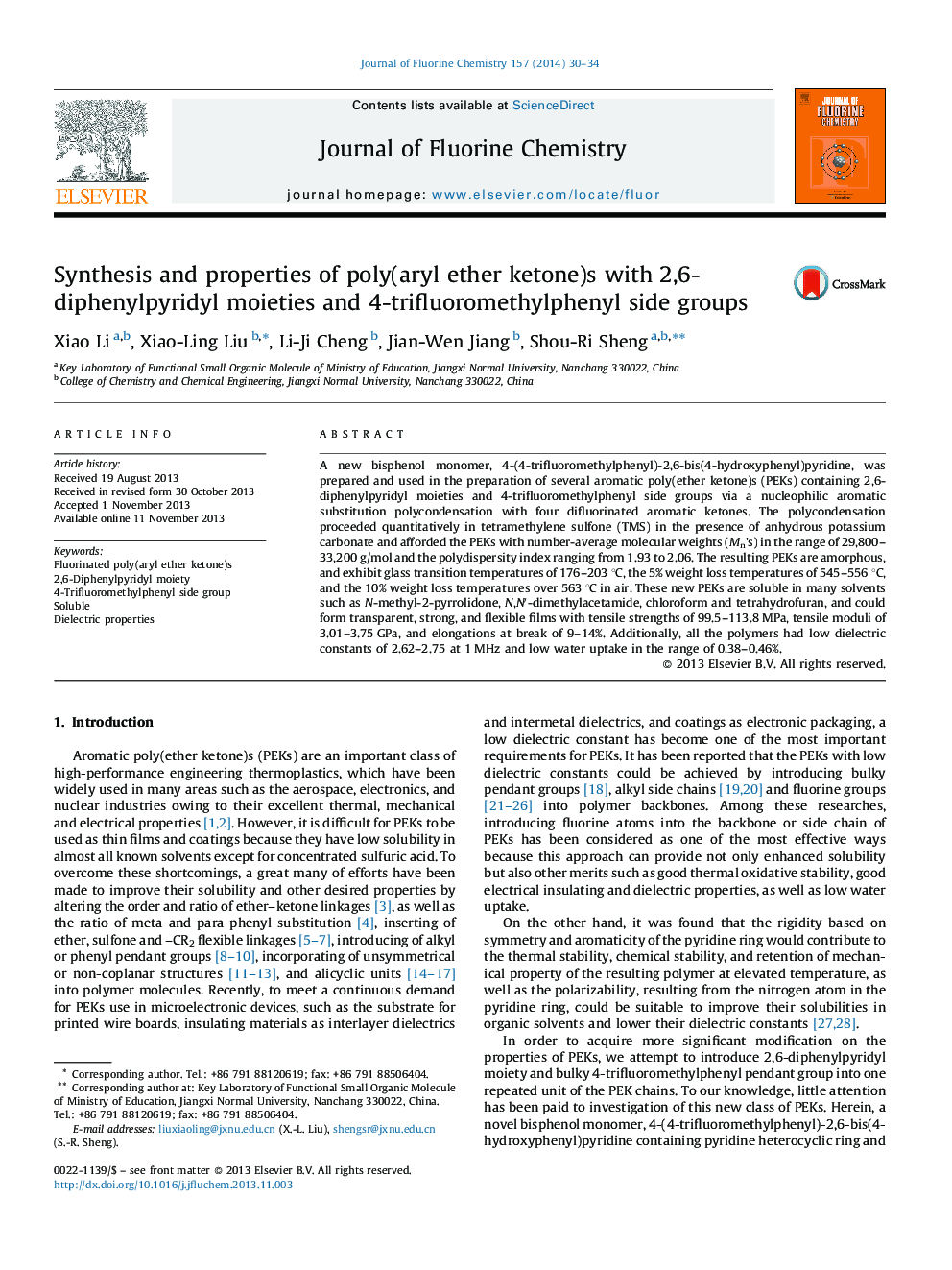| Article ID | Journal | Published Year | Pages | File Type |
|---|---|---|---|---|
| 1313670 | Journal of Fluorine Chemistry | 2014 | 5 Pages |
•New bisphenol of 4-(4-trifluoromethylphenyl)-2,6-bis(4-hydroxyphenyl)pyridine was synthesized.•Several fluorinated pyridine-containing aromatic poly(ether ketone)s (PEKs) were developed.•These PEKs have low dielectric constants, good solubilities, and excellent thermal stability.
A new bisphenol monomer, 4-(4-trifluoromethylphenyl)-2,6-bis(4-hydroxyphenyl)pyridine, was prepared and used in the preparation of several aromatic poly(ether ketone)s (PEKs) containing 2,6-diphenylpyridyl moieties and 4-trifluoromethylphenyl side groups via a nucleophilic aromatic substitution polycondensation with four difluorinated aromatic ketones. The polycondensation proceeded quantitatively in tetramethylene sulfone (TMS) in the presence of anhydrous potassium carbonate and afforded the PEKs with number-average molecular weights (Mn's) in the range of 29,800–33,200 g/mol and the polydispersity index ranging from 1.93 to 2.06. The resulting PEKs are amorphous, and exhibit glass transition temperatures of 176–203 °C, the 5% weight loss temperatures of 545–556 °C, and the 10% weight loss temperatures over 563 °C in air. These new PEKs are soluble in many solvents such as N-methyl-2-pyrrolidone, N,N′-dimethylacetamide, chloroform and tetrahydrofuran, and could form transparent, strong, and flexible films with tensile strengths of 99.5–113.8 MPa, tensile moduli of 3.01–3.75 GPa, and elongations at break of 9–14%. Additionally, all the polymers had low dielectric constants of 2.62–2.75 at 1 MHz and low water uptake in the range of 0.38–0.46%.
Graphical abstractA new bisphenol monomer, 4-(4-trifluoromethylphenyl)-2,6-bis(4-hydroxyphenyl)pyridine, was prepared and used in the preparation of several aromatic poly(ether ketone)s (PEKs) containing 2,6-diphenylpyridyl moieties and 4-trifluoromethylphenyl side groups via a nucleophilic aromatic substitution polycondensation with four difluorinated aromatic ketones. The polycondensation proceeded quantitatively in tetramethylene sulfone (TMS) in the presence of anhydrous potassium carbonate and afforded the PEKs with number-average molecular weights (Mn's) in the range of 29,800–33,200 g/mol and the polydispersity index ranging from 1.93 to 2.06. The resulting PEKs are amorphous, and exhibit glass transition temperatures of 176–203 °C, the 5% weight loss temperatures of 545–556 °C, and the 10% weight loss temperatures over 563 °C in air. These new PEKs are soluble in many solvents such as N-methyl-2-pyrrolidone, N,N′-dimethylacetamide, chloroform and tetrahydrofuran, and could form transparent, strong, and flexible films with tensile strengths of 99.5–113.8 MPa, tensile moduli of 3.01–3.75 GPa, and elongations at break of 9–14%. Additionally, all the polymers had low dielectric constants of 2.62–2.75 at 1 MHz and low water uptake in the range of 0.38–0.46%.Figure optionsDownload full-size imageDownload as PowerPoint slide
